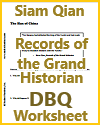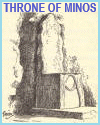Click here to print this sheet of writing exercises on India's Gupta empire (PDF file).
1. In Gupta society, women's roles were largely centered around the household, with their primary responsibilities being marriage, motherhood, and domestic management. Their status was generally subordinate to men, reflected in legal and social norms that restricted their rights and freedoms. However, some women, especially those from higher castes, had access to education and participated in religious and cultural activities. Despite societal constraints, women played crucial roles in maintaining family and cultural traditions.
2. The Gupta Empire, spanning from approximately 320 to 550 C.E., is considered a golden age of India due to its significant achievements in arts, science, and literature. This period saw advancements in mathematics, including the concept of zero and the decimal system, as well as flourishing art, architecture, and literature, such as the works of Kalidasa. The era was marked by political stability, economic prosperity, and cultural development, laying foundations for future generations.
3. The Guptas were influenced by the preceding Mauryan Empire's administrative practices, adopting and refining its governance and bureaucratic systems. They were inspired by the cultural and religious traditions of the Kushans, incorporating Buddhist and Hindu philosophies. Trade connections with Rome and Southeast Asia also influenced Gupta art, coinage, and architecture, integrating Greco-Roman and Persian elements, which enriched their cultural and artistic expressions. |











